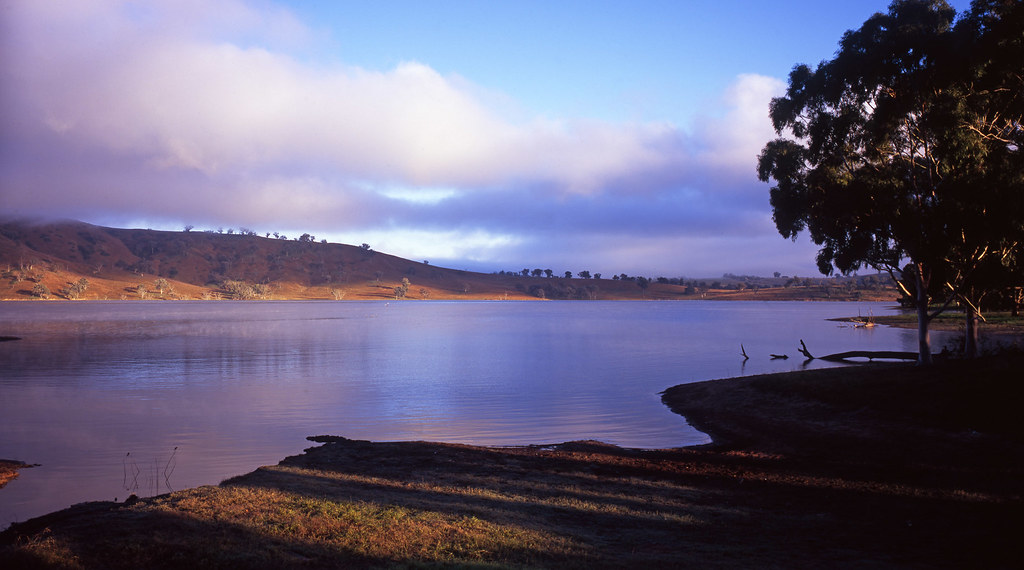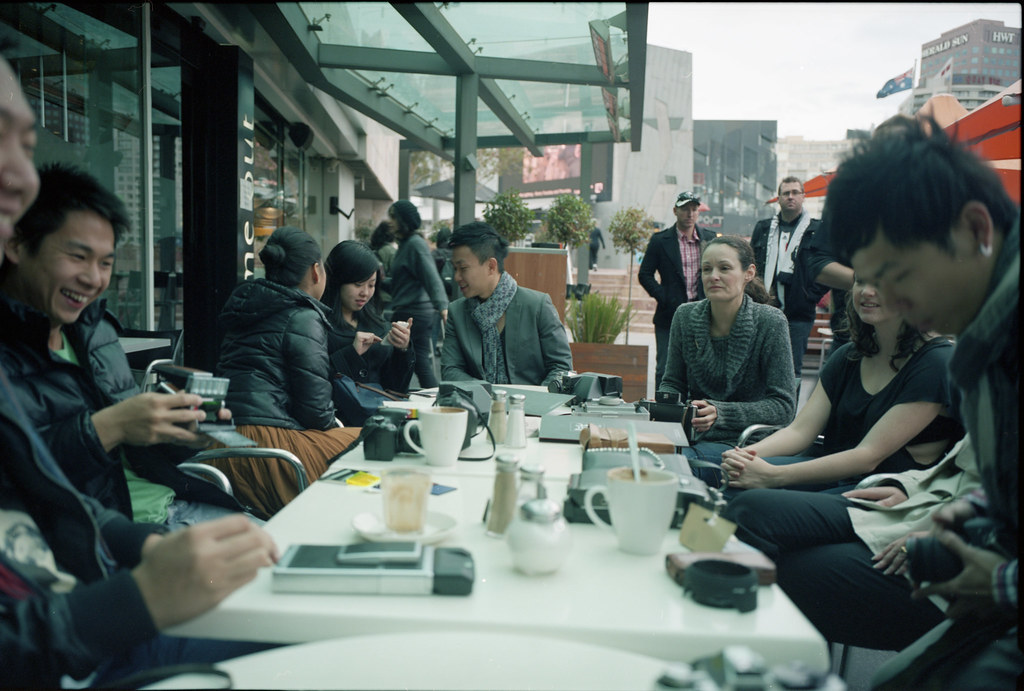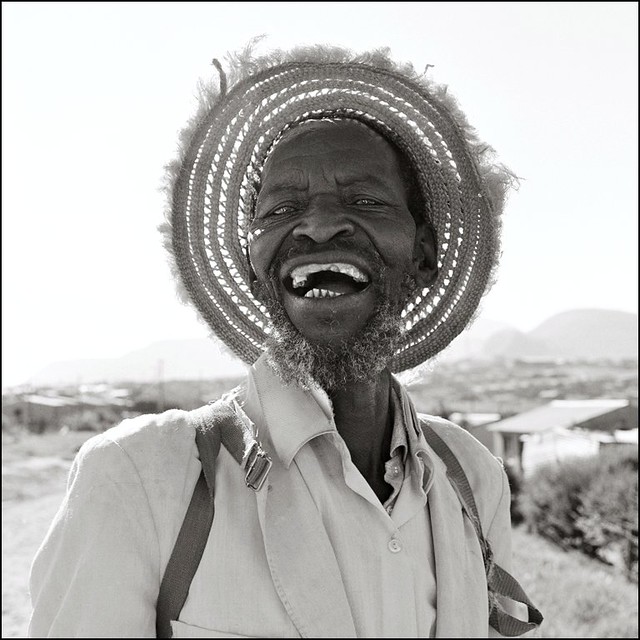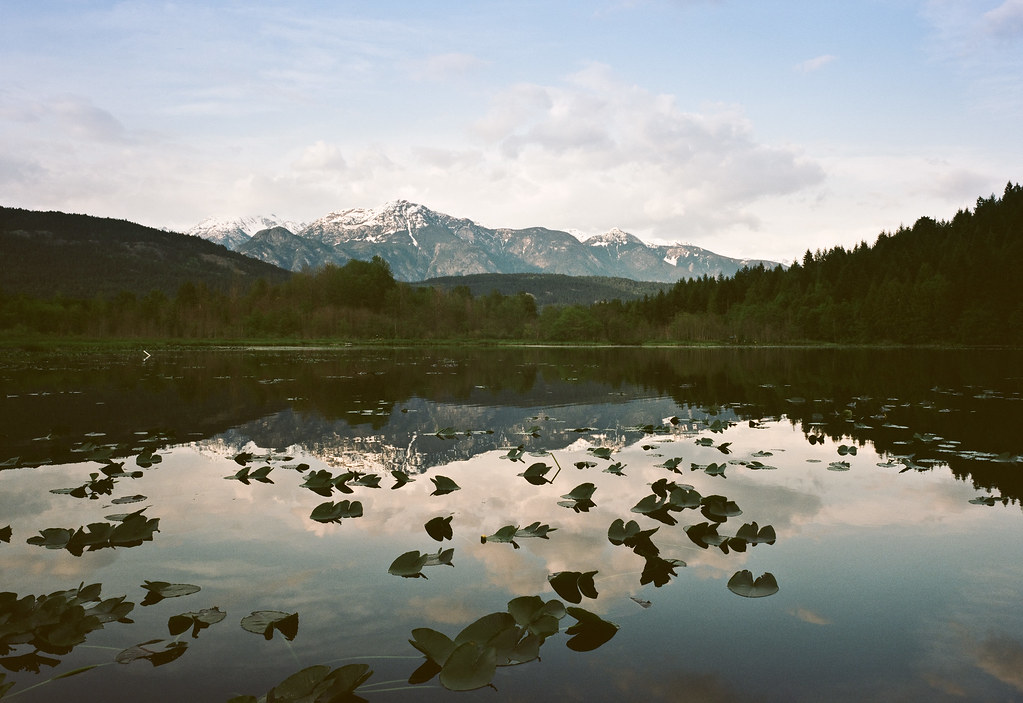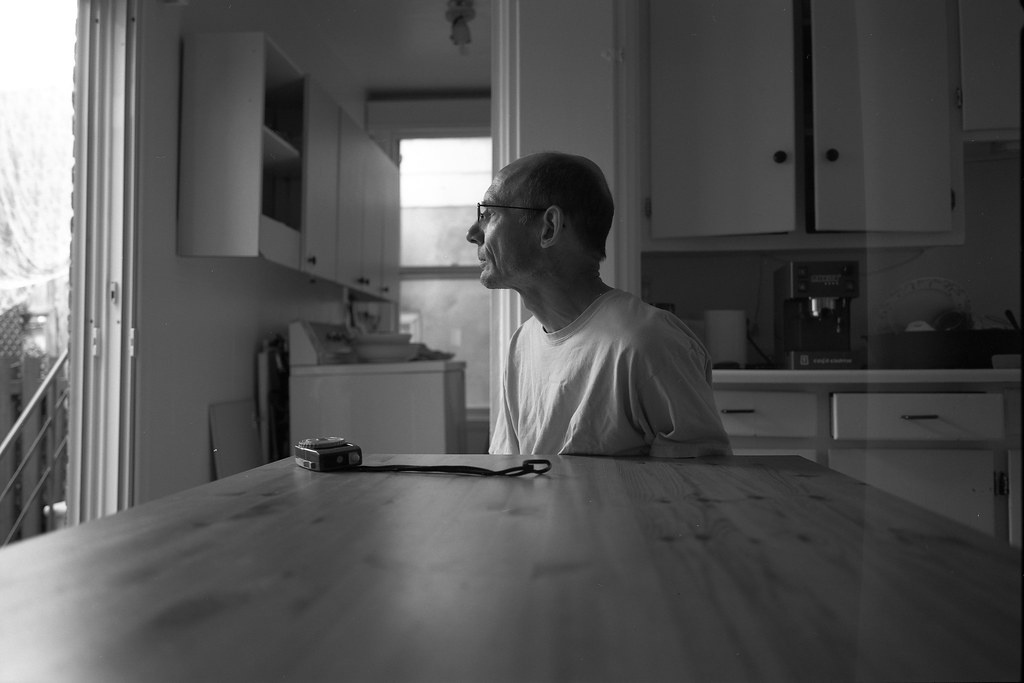Well I don't find my RB67 a problem at 8lbs in a back pack + 35mm SLR, and I don't know what weight would I find unbearable as I took 16lbs of camera gear to Ibiza and didn't find that a problem, also in a backpack.
Well Brian, you must have a very understanding airline

if you can carry 16lbs of camera, plus luggage, when you go on holiday. That would be too much for me, I have to say.
Although I expect to do most of my MF shooting locally, I really do want a set up which is light enough to pack (either partially or completely) into my hand luggage when I go abroad. I'm starting to get the impression that if I did own an RB67 (great value though they are at the moment), it might end up being left at home if I was going travelling

.
After retuning to film with 35mm and enjoying the limitations of it I was tempted to try Medium Format. I didn't have or want to spend much money on it and acquired a Yashica Mat on the bay for a few quid.
I loved it. Still love it.
I shoot it in order to take my time. Always on a tripod, more than happy to go out and make just 1 picture. Slow slide film and small apertures is my way. It's not everyone's and may not be yours.
But there is magic in that big square...
(still use 35mm for walkabout)
I use CC Imaging for develop and scan btw.
You raise a good point there, Trevor - one which I should have clarified in my earlier post

. Yes, I too intend to use the MF format for 'studied' landscape and still life photography. I don't 'do' portraiture and have other cameras better suited to 'faster' forms of photography.
I will certainly check out the TLR options, as you suggest. The sample images that I found when I just Googled "Yashica Mat" were mostly of the kind of (high) quality that I am searching for.
Thanks for the post.
Hi Andy,
At the moment there does seem to be a movement toward TLR's in this musty little section.They are light and produce lovely 6x6 negs from which even I can manage some half decent pics. As to the problem with 1/500 of a second this image was taken on a brilliantly sunny day (one of the few) in mid-afternoon on a Yashica A which only goes up to 1/300th, no filters or grads were used.
(snip)
Cheers
Andy
Andy, does your Yashica have a 'bulb' exposure mode? It's more the long exposures that I am concerned about than the short ones, I guess, as I have ND filters.
Nice results there, BTW

.
Hey Andy,
I am in your exact position and after my research google + flickr - I am saving up for a Fuji gw690II . Also, it has the 6x9 format - i know people love the square 6x6 but it just doesn't suit me.
In my experience the V500 is really good value - getting dust etc off my 35mm negs just requires patience - longer washes at the end of dev and using a blower on the scanner and negs for 2/3 mins before each scan.
Hi Mel,
The Fuji looks like another very tempting proposition

. I love the portability aspect of it. The initial images that I found from that camera/lens combo looked a little soft, which is why I took it off my list, but I guess that I might have just found some poor examples. I need to go and have another look at that, because there are several of these on eBay right now, at affordable prices

.
I look forward to seeing what you do with yours, when you get it, Mel.
6x6 is the way forward. As has been mentioned on another thread "it's hip to be square"

As Freecom has kindly and expertly swept up most of the muck in this thread, it looks like its a what have you got and how do you like it thread.
So I'll add mine for perusal.
the good -
I mostly shoot Mamiya 6 RF, its light and more compact than the 7, marginally less expensive but still a serious wallet full with glass.
It meters perfectly, the lenses are sharp and its very easy and convenient to use, I measure the product of all my MF cameras past and present against it because its freakishly reliable and consistent.
the bad -
There are only 3 lenses available for it, 50, 75, 150
It does not close focus well at all, can't fill a 6x6 frame with a head shot.
RF focussing does not suit everybody, it takes a bit of getting used to.
the good -
Bronica ECtl SLR, similar in size and weight to a 500CM so its reasonably light, but with a 250mm f4 on the front....not so.
EC & ECtl's won't break the bank and the lens range is huge.
I use it for studio but you can hand shoot it with wlf or a prism pretty easily with wides through to mid teles.
This thing close focusses like a champ, 500CM can't get close to it, all the glass is very good, not zeiss good but pro quality good.
It uses film backs.
the bad -
Its a focal plane shutter, with a big split mirror banging up and down every frame.
This system is now 40+ years old.
The ECtl is metered but you can't bet your life on correct exposure.
If it breaks....its broke for good in all likely hood.
Neither of these 2 cameras are the cheapest route in to MF, but if you want light/convenient, if you want choice of lenses and metering, they usually cost more..

Thanks a lot for posting your thoughts, John - that's exactly what I was inviting people to do.
The Bronica ECtl is one that 'got under the radar', so thanks for bringing that back to my attention. I looked at the Bronica ETRS and saw that it only produced 645 format negs and consequently 'tarred all other Bronicas with the same brush' :bonk:.
I'll add to the comments that the rb67 is NOT too heavy. I have taken mine with one lens and waist level finder on holiday to Europe twice now, no worries. I also like to carry it when out hiking.
I also love my Seagull TLR, though everyone else seems to hate them. A Japanese or German one would be way better of course, but for the price I got mine (before the Lomography days), I can't complain.
The key with medium format is finding the frame size and camera type that suits you and your budget. The MF rangefinders are all (as far as I know) superb and easy to carry around. TLRs are nice too, none are particularly cumbersome bar the Mamiyas, which make up for their relative largeness and weight with the extra flexibility of interchangeable lenses. I'll let others comment on SLRs, all I can say is that if you aren't averse to a bit of mass, a Mamiya RB/RZ is king. Only shortcoming of the Mamiyas if you ask me is the lack of fast glass.
I must admit, I loved the idea of the Mamiya 6 or 7 when I first saw them, but the prices and the lack of wide angle lenses (for the 6 in particular) really put me off. I know that focal lengths for 120 film cameras are 'wider' than on 35mm cameras, but 50mm only translates to about 28mm, which is not quite as wide as I would like for what I have in mind. As for the aperture values available for the RB/RZ lenses, I hadn't really noticed that yet, but I will keep it in mind.
Thanks for your input.
As already stated above, a TLR might be a good way to go. Relatively portable and comparatively unobtrusive too.
Personally I have a Mamiya RB67, and love using it especially the larger negatives, focussing is not an issue either. It's a bit of a beast but, to me anyway, is not much worse than lugging my DSLR and a few lenses around and the increased picture quality and the ability to use different film stocks (I am a sucker for Velvia and also Acros and Ektar) makes up for any additional weight.
I always have to use it on a tripod whereas that might not be the case with a TLR, so that might also be a factor?
There is no meter in my 67 but I used an ancient analgoue meter which worked fine and have eventually moved up to a 'proper' spot meter (mostly since moving up again to large format which is the only reason I am considering selling the 67 at the moment)
Large format looks rather expensive to me (for film and developing), but I wish you luck with that.
Funnily enough, Velvia and Acros are probably the two films that I intend to use too.
Thanks for sharing your thoughts.
If you want light and not too expensive, what about one of the folding Zeiss Ikonta rangefinders? :nuts:
It's an interesting suggestion, but I really want to have the possibility of using at least one UWA lens (sorry, I should have said that in the original post) and so a fixed focal length camera is out.
My RB67ProSD was probably my favourite camera to use of all time, I absolutely loved it. In fact I've been looking on Ebay and can't believe how little they are going for now. I was a bit younger and a lot fitter then but could happily walk all day in the Lake District with my RB kit comprising of 50, 65, 90, 127, 180 and 250mm lenses, plus a few 120 backs and a prism all in a LowePro Trekker. For landscapes I mainly used the 65mm, not very wide but it suited me, for weddings and people I would use the 127 and 180mm, I rarely used the 50, 90 and 250mm lenses. The prism did have a built in meter with spot and average but I always used a hand held meter, although for landscapes I preferred the waist level finder.
For travelling I replaced it with a couple of Mamiya 7II rangefinder cameras with 50, 65, 80 and 150mm lenses. Once again I mainly used the 65mm and occasionally the 150. Again there was a built in meter that I didn't use preferring a hand held meter. These cameras were great for travelling, not that much bigger than a pro 35mm camera and the lenses were much smaller and compact. They appear to have held their prices very well and are still an expensive option
I also had a small C330f twin lens kit with 55, 80 and 135mm lenses. I mainly used the 80mm for street photography and found that with the waist level finder, no-one was aware of their picture being taken.
For a while I had a small 645ProTL kit with 55, 150 and 300mm lenses and a prism. I used it with the prism but with the crank wider, not with a grip.
I enjoyed using all of these Mamiya cameras and miss the process of shooting medium format. If I had to choose one, it would be the RB...ruddy brilliant!
Thanks Richard, lots of good info there.
I think that for value for money, the RB looks like a really good choice right now, but I'm fairly sure that it would be too bulky for me to travel with. Shame really!
Don't dismiss the 645 too quickly. The negs are over 3 times bigger, 15 shots to a 120 roll and more portable than the 67s. I've got a mamiya 645 which can shoot up to 1/1000 sec and has a wide range of lovely lenses available for surprisingly little money and you can even find a f1.9 80 mm lens. The system is modular, I use a metered prism which gives me well exposed negs.
Mike
Hi Mike!
I will certainly try to keep an open mind as I go through all the options. I do suspect though that if I was to go with a small MF (645), I would always be left wondering, "What if ...?"
I
hate that feeling

!
As above, I have recently purchased the mamiya 645 pro, and have both the waist level finder and the metered prism.. it,s not to heavy and as already said meters well with the prism fitted..
Sounds like a really nice camera and I know that the prices are very attractive these days. Who knows, if I really get the MF bug, I might add one to the collection for 'street' stuff.
Enjoy yours, Steve!
I have the GSW690II ( wide angle version) and it's a great piece of kit. I have only managed to put two rolls through it so far, so still getting to grips with it. I managed to get mine from Japan on the well known auction site and was lucky enough not to get charged any customs fees, and saved quite a bit on what UK sellers were asking (even of I did get charged it would have been cheaper). Just need the weather to improve so I can get out with it again.
I have seen three of them on eBay this week, from a Japanese seller. Great to hear from someone who has gone down that route and found success with it. Congratulations on your purchase, Kev.
Glad to be of assistance, it keeps my mind fresh on the various options as well (not that my GAS needs it). Yes, the scanner is definitely worth thinking about, although a route into MF isn't necessarily a bad thing - because otherwise it might be a nagging want until you fulfil it, if you never know whether it was for you or not without trying it. We mention medium format on Film & Conventional so much that you end up being intrigued by it!
Controlled grain is definitely a big plus. I shoot T-Max 400 dev'd in T-Max Developer, which is already quite minimal grain at 35mm level, but at medium format it can be tough to find the grain to focus on when printing.
As for loading - loading is a pain with any format :bang: I use reels with wide flanges though, they are a little more difficult to get than the Paterson normal reels but well worth having a look out for.
RE: the weight of RB/RZ67, as some of the following posts after yours have shown, it really is a subjective thing. I personally find even my current shooting outfit too heavy (D7000 + 17-50 f/2.8 on one shoulder, Rolleiflex 3.5F on the other), but for some people that combined weight is nothing. The advantages of the additional negative size with 6x7 is a big draw for a lot of people (and many of the people who posted above will often cite that as to why they shoot with it), but for me outweighed by the disadvantage of their weight and ideally needing to be shot with a tripod; not a necessity, but I have sharp shots with TLRs at 1/8th and 1/4th of a second, which simply would not be possible handheld with the RB/RZ system.
Lots of talk of 6x7 rangefinders/SLRs, lots of talk about 6x6 TLRs, but many other types to consider. 6x4.5 does offer a lot and often in a much more neck/shoulder acceptable weight, and there are a few rangefinders and several SLR systems in that size. With 6x6, there are the SLRs - the Bronica SQ, Hasselblad 500, Kievs, Pentacons, and the rangefinders - Mamiya 6 springing to mind.
The world of medium format, even with far fewer cameras, is much more varied and with many different ways to shoot 120 film.
Thanks again for your continued input, f2.
To pick up on what you said about tank reels, I too have now managed to get my hands on some reels with flanges (Kaiser brand), which work for 35mm or 120 film.
My preferred b&w combo is Fuji Acros 100 developed in Diafine, which is even pretty much 'grain-free' on 135 film - I can't quite imagine how clean it would look with 120 film!
Anyway, you and everyone else here have given me a lot to think about and a lot more options to consider, for which I am very thankful

.
I intend to have a closer look at the TLRs and see what options I might have there for interchangable (UWA) lenses. I also think that the RB/RZ67s are not really for me at this stage, due to the difficulty of flying with that much kit in my luggage.
Aside from that, the Hasselbald still appeals and now I know about the (broadly similar?) Bronica ECtl camera, I can check those out too.
If I come up with any more specific questions, I'll come back and post them here.
Cheers!
Andy
 , but I have done those things and am not really finding the kind of information that I want. Instead, I thought that I'd open this thread and ask only those who genuinely enjoy discussing camera equipment and sharing their knowledge and opinions to take part, in order to help me get a better overview of what's out there. I hope that's OK with you all
, but I have done those things and am not really finding the kind of information that I want. Instead, I thought that I'd open this thread and ask only those who genuinely enjoy discussing camera equipment and sharing their knowledge and opinions to take part, in order to help me get a better overview of what's out there. I hope that's OK with you all  !?
!? !
! ). That said, as a starting point, let's just say that I would like something which has top quality glass available for it, is not overly heavy or hugely bulky, has some form of built-in light meter and has a reputation for good build quality and reliability.
). That said, as a starting point, let's just say that I would like something which has top quality glass available for it, is not overly heavy or hugely bulky, has some form of built-in light meter and has a reputation for good build quality and reliability. . Could you get around that in daylight by using ND filters and is there a way to extend the exposure times (i.e. 'bulb' mode) for night time use :shrug:?
. Could you get around that in daylight by using ND filters and is there a way to extend the exposure times (i.e. 'bulb' mode) for night time use :shrug:? .
.  . Could you get around that in daylight by using ND filters and is there a way to extend the exposure times (i.e. 'bulb' mode) for night time use :shrug:?
. Could you get around that in daylight by using ND filters and is there a way to extend the exposure times (i.e. 'bulb' mode) for night time use :shrug:?

 !
!
 .
.